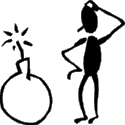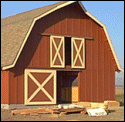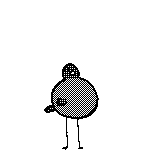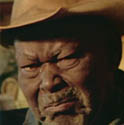|
WAFFLEHOUND posted:Listening to them side by side, I think the thing that I'm hearing is more high-end on the samples you've made. Still, wow, that's an amazing analysis. If you want to simulate that, the best way of replicating that, is just going through that process yourself: play the sample through the speaker of your phone for example and record it with a mediocre microphone. Alternatively, look into lo-fi and/or impulse response plugins. Not saying this sample is worth all that when a bit of equalizing might do, but it's something you shouldn't be afraid to do in general. It provides interesting results that are hard to replicate exactly otherwise. As for the analysis, a good parametric equalizer with very narrow Q options helps pinpoint frequencies pretty exactly. With a decent boost, poo poo just starts to ring when you hit the jackpot.
|
|
|
|

|
| # ? May 27, 2024 10:11 |
|
Can someone tell me if the starting riff of this song was made on a synth, and if so how to recreate it? https://www.youtube.com/watch?v=CMvUfNOXXgU
|
|
|
|
Here's an another riff related question. Any pointers on what waveform / filter combos this riff might use? I guess saw and at least highpass? I've been trying to replicate this in massive, but I'm not getting the same bite and buzz this has going on.
|
|
|
|
https://www.youtube.com/watch?v=Fmg9KqrIqfM&t=36s I really like the lead that comes in here that sounds kinda like a guitar, and I'm curious as to how I would go about making it in Massive (assuming it's not a sampled guitar).
|
|
|
|
|
slardel posted:I've tried to recreate or find the right sample to achieve this delayed atmospheric rainstick/shaker sound so many times, but I've never gotten it sounding quite right and I always end up giving up and scrapping it. Sounds like a maraca...it sounds like two maracas, one for each channel on the first example, and a single maraca getting recorded by an XY stereo pair of microphones in the second example. I have a very particular sound I've never been able to find the origin of. It starts 34 seconds in to Verve's Bittersweet Symphony hard-panned to the right channel: https://www.youtube.com/watch?v=aVlGeynp8B0&t=34s What is making this delightful noise??? It sounds sort of like a tape delay loop with its rate altering, bending the pitch around with a constant note as its input...ebowed guitar maybe? I haven't seen it recreated in live performances.
|
|
|
|
Barn Door posted:What is making this delightful noise???
|
|
|
|
Forums Terrorist posted:Can someone tell me if the starting riff of this song was made on a synth, and if so how to recreate it? This is definitely square waves on a certain oscillation with resonance added. I'm pretty sure there's more than one synth at work here. A very simple 80's sound, and I'll hazard a guess that this was done with a Juno 06. I'll try to recreate it when I get FL Studio up and running.
|
|
|
|
Any tips or advice on these cool sounds I've been wondering about would be really great... https://www.youtube.com/watch?v=rmrmdYAsDk0 There's a sick reverse kick or something there on every 8th beat... but I'm not totally sure. Any thoughts how I could recreate that? http://soundcloud.com/itsmodamusic/tom-staar-two-tone-simms-ado-1 The absolutely savage reverse woop synth there... specifically what comes in after the drop though it's there for the build up. I need that in my productions... This is more a Sidechain effect I've been trying to master, where the bass pumps every off beat as in this: https://www.youtube.com/watch?v=c_zKljvH7AM I'm looking to get that full on kick you in the chest pump with the bass but my sidechains seem to leave so much bass on the kick beat that it never generates that same feeling... I have a feeling this goes beyond simply chaining a ghost kick with my bass? 
|
|
|
|
Not specifically a how-do-I question, but I was wondering, what's the difference between analog oscillator waves and mathematical ones (like most software synths use)? Since I keep seeing that "virtual analog" term thrown a lot lately. Is it minor self-oscillation that's expected from analog synths on sharp waveforms (saw, pulse, etc)?
|
|
|
|
Combat Pretzel posted:Not specifically a how-do-I question, but I was wondering, what's the difference between analog oscillator waves and mathematical ones (like most software synths use)? Since I keep seeing that "virtual analog" term thrown a lot lately. Is it minor self-oscillation that's expected from analog synths on sharp waveforms (saw, pulse, etc)? Honestly, there isn't one. Analog oscillators have small eccentricities and "errors" that are considered to add character to the tone. Outside of something like a Metsonix tube osc, which is designed to be weird, the difference is negligible. The term "virtual analog" came about in the mid '90's when people got tired of romplers and synth manufacturers started making digital synths with an osc->filter->envelope signal path again. It really refers more to the structure than the sound, if you have a synth with a self resonating filter and knobs on the user control side of things then you have a "virtual analog" synth regardless of whether it is designed to emulate analog circuitry. The Ensoniq Fizmo is probably considered to be a virtual analog design, for example, despite being a purely digital synthesizer. The only tangible difference, with regards to a conceptual ideal versus the machinery used to produce the tone, would be in resolution, bit depth. An 8 bit replication of a sine wave isn't really all that close to a sine wave, but a 16 bit one is.
|
|
|
|
Oh okay. I'm just wondering about this for a later project of mine. Right now I'm writing a synth app for Windows 8, which is "virtual analog" I guess (I'm using osc->envelope->filter in that order right now) and supports automation of various knobs via envelopes and a LFO. Later on, when my list of project's done with, I was considering writing a fully modular synth out of personal interest, and was looking for some information on this mysterious "analog sound" a lot of musicians rave about. I'd like to make something able to do GusGus like sounds. Speaking of which, I've uploaded a demo of the app: https://www.youtube.com/watch?v=P7h3e7mQTQQ
|
|
|
|
Sizone posted:Honestly, there isn't one. Analog oscillators have small eccentricities and "errors" that are considered to add character to the tone. Outside of something like a Metsonix tube osc, which is designed to be weird, the difference is negligible. There is definitely a difference in tone between a digital oscillator and an analog one. A mathematically pure oscillator tone sounds very cold and clean, whereas a pure analog VCO sounds quite warm and thick, and a little fuzzy because each cycle is slightly different due to all the minor flaws in the circuit that add up to create additional harmonics over the base frequency. Most modern VSTs and virtual analog synths have extra fuzziness and harmonics programmed into their oscillator generation algorithms to simulate this, and the effectiveness of this varies from company to company depending on how well they've emulated the instability of analog circuitry (they're effectively adding deliberate flaws to the otherwise pure, clean tone a mathematically perfect tone would have). A similar thing happens with digital vs. analog filters. The reason why I got rid of my Nord Modular was because after buying a real analog modular and a bunch of other analog synths, I just was not happy with the sound of the Nord - it sounded too flat and sterile, and it can largely be blamed on the fact that it's really just some software running on a couple of custom DSP chips in a box. This is not to say I don't care for digital synths at all; I use a ton of VSTs (Albino, FM8, and impOscar in particular) and VAs/ROMplers (Novation X-station, Roland SH-32 and JX-305), and one of my favourite vintage synths I own has digital wavetable oscillators running through analog filters and sounds thicker and warmer than most of my pure analog synths (Korg DW-8000). Digital can sound as good as analog, if it's done well. It's not often or always done well, however. Militant Lesbian fucked around with this message at 17:57 on Oct 6, 2012 |
|
|
|
Sizone posted:The term "virtual analog" came about in the mid '90's when people got tired of romplers and synth manufacturers started making digital synths with an osc->filter->envelope signal path again. It really refers more to the structure than the sound, if you have a synth with a self resonating filter and knobs on the user control side of things then you have a "virtual analog" synth regardless of whether it is designed to emulate analog circuitry. I may be biased, but to me virtual analog means more than just the basic module structure of a synth. The term came to prominence (the first usage was the silk-screening on Clavia's Nord Lead) as micro-processors increased in power and dropped in price. This enabled non-naive DSP emulations of analogue synthesis that were previously impossible: band-limited oscillators supporting FM cross-mod, sync, and pulse width modulation (features which romplers simply can't perform adequately); exponential envelope curves; LFOs into the low audio range; non-linear frequency and phase responses; non-aliased modulation; etc. You're sadly right that in marketing terms "virtual analog" has now just come to mean providing a few filter knobs on the fascia, though. However, that doesn't mean my ears and wallet will accept buzzy aliased oscillators, faked self-oscillating resonance, and a lack of smooth pulse width modulation. HotCanadianChick posted:Digital can sound as good as analog, if it's done well. It's not often or always done well, however. Yep. drat right on both those points.
|
|
|
|
CareyB posted:http://soundcloud.com/itsmodamusic/tom-staar-two-tone-simms-ado-1 Distorted analog filter with the resonance up high, attack on the filter envelope sweeping it up. Very simple to make on something like a Doepfer Dark Energy. CareyB posted:This is more a Sidechain effect I've been trying to master, where the bass pumps every off beat as in this: https://www.youtube.com/watch?v=c_zKljvH7AM I'd buss the kick and bass together into a heavily pumping compressor to keep the whomp strong, and apply some characterful EQ & channel distortion before/after the compression to taste.
|
|
|
|
I really love the vocoder-like effect on the vocals in this Horse the band song http://youtu.be/sez8k-GF3J0 starts at 1:35. Like I said, I'm pretty sure it's a vocoder, but there's this certain muffled texture to it that drives me crazy and I want to recreate it in one of my band's songs as close as possible. The only vocoder I really have access to at the moment is the one on the miniKorg, but I'm sure some studio fuckery shouldn't be too out of the question.
|
|
|
|
ynohtna posted:Distorted analog filter with the resonance up high, attack on the filter envelope sweeping it up. Very simple to make on something like a Doepfer Dark Energy. Cheers for these, looking forward to finding the time to try them out...
|
|
|
|
Barn Door posted:Precisely. Strum only G and B strings. Bend G string up on fret 15 and hold B string steady on fret 13. Heavy distortion. Beleg posted:havent played anything heavy for years, but it sounds like he's playing at least two notes and bending up one of them. the guitar signal probably goes through some modulation, either chorus/phaser and a nice wah. This is long-belated, but thanks to both of you!
|
|
|
|
Any insight in modular systems? I know that CV/G voltages go from 0V to 10V, but what about the audio signal, is it also 0V to 10V with the zero at 5V, or is it -5V to 5V or something like that? I'm looking for some info for properly simulating such a system.
|
|
|
|
In general CV is 0 to X and audio is -X to X. In Eurorack practice whether it's really 0 to 10 or -5 to 5 or -10 to 10 or whatever depends on the module and manufacturer. Some modules have AC/DC switches to toggle between the two. There are plenty of modules that will let you offset an AC signal so that it fits in a DC range, and so on and so forth. Depending on your definition of a proper simulation, keep in mind that there are good reasons why there isn't one yet. Something along the lines of a Nord Modular is relatively easy (though still a lot of work), but what I would call a proper simulation that lets you modulate everything at audio rates with high quality and includes lots of non-linear effects and so on is a significant technical challenge. Sizone posted:The only tangible difference, with regards to a conceptual ideal versus the machinery used to produce the tone, would be in resolution, bit depth. An 8 bit replication of a sine wave isn't really all that close to a sine wave, but a 16 bit one is. This is not true at all. An 8 bit sine wave has a higher noise floor, but there is no reason it should otherwise be any worse than a 16, 32, or 4096 bit sine wave, as long as dithering takes place whenever the bit depth changes. You can run a full scale drumloop into a bitcrusher set to 3 bits and the loop itself will sound fine if you also send a good bit of high-passed white noise in along with it... There will obviously be a lot of noise with such a low bit depth, but that's not the same thing as the loop itself being distorted.
|
|
|
|
breaks posted:Depending on your definition of a proper simulation, keep in mind that there are good reasons why there isn't one yet. Something along the lines of a Nord Modular is relatively easy (though still a lot of work), but what I would call a proper simulation that lets you modulate everything at audio rates with high quality and includes lots of non-linear effects and so on is a significant technical challenge. I'm planning to run all modules in lockstep for each sample. A bunch of initial tests showed this as possible with several placeholder modules, all within a certain performance envelope. The only drawback, if you could call it that, is that to prevent circular dependency issues, the output ports will always be one sample behind what the module is doing. Like this I don't need to check for dependencies, and you could loop a signal either way. Each module would rack up 0.023ms of latency, which I figure is acceptable. So, having an audio signal control a module should theoretically be possible. Some filters become unstable, if you change parameters every sample, so with these I might have to throttle it to every 2nd or 4th.
|
|
|
|
Yeah, that's a reasonable approach and along the lines of what most software modulars do as far as I'm aware. You can build a great synth that way that will handle a ton of "normal" patches just fine. All I'm saying is, just be aware that it will not come out sounding like a hardware modular when you start getting into very fast (audio to ultrasonic) modulations, feedback patches, and other such stuff that software generally doesn't handle well at reasonable sample rates. There are a few recent plugins that are doing a much better job of simulating some of that stuff in a realistic way (Diva and The Drop in particular) but they are borrowing some techniques from circuit modeling packages and are very CPU intensive. breaks fucked around with this message at 18:41 on Oct 20, 2012 |
|
|
|
Depending on how the CPU load is of larger patches, once this project is in a more advanced state, I may introduce 2X oversampling. Right now it just supports a simple lovely sine generator and an output, since I'm still toying with what the core architecture will be. Out of curiosity, what is ultrasonic modulation good for? Any results from this would get antialiased away once it goes into digital domain.
|
|
|
|
With some modules it doesn't do much, or I often find turning up the amount of ultrasonic modulation has similar effects to turning down the parameter it's modulating. Some modules combine input signals in such a way that it changes the sound in ways that don't seem to happen with other inputs, though. The top section of the Bubblesound cvWS comes to mind. Also sometimes when you have multiple oscillators FMing each other diming the pitch of one of them can get you some cool textures, though in this case of course it's dipping downward into an audible range unless the FM amount is pretty tiny. Mostly I've used it for this sort of thing, making gritty textures to sample and turn into hat sounds.
|
|
|
|
I'm playing keyboards with some friends for a live Daft Punk set and I'm having a bit of trouble recreating the lead in "Da Funk" (1:00 into the song) http://youtu.be/IewQqGpdmh8 Right now I'm using Arturia Minimoog and have something that sounds pretty close to the line except for a complete lack of that nasty-awesome growl, which I think is vital to the song. The noise generator on the Minimoog doesn't really give me a convincing growl. Any suggestions? EDIT: I'm also doing all of this in Ableton Live.
|
|
|
|
Can someone remind me what keyboard/synth is used to make that mellow sound in songs like Kennedy's "Karate"?
|
|
|
|
https://www.youtube.com/watch?v=dMlwr0_wlV4 The synth horns in this song. Please help, I need them.
|
|
|
|
Miscellaneous_T posted:I'm playing keyboards with some friends for a live Daft Punk set and I'm having a bit of trouble recreating the lead in "Da Funk" (1:00 into the song) Distortion
|
|
|
|
bencreateddisco posted:The synth horns in this song. Sounds like a couple of detuned oscillators (maybe saws) with a short decay, played through reverb and a bandpass filter or an EQ to make it thin. You could probably do this with SQ8L, the oscillators sound similar to my ear. Cameron posted:Can someone remind me what keyboard/synth is used to make that mellow sound in songs like Kennedy's "Karate"? I think it's a synth organ played through a chorus and a phaser. Further than that, no idea.
|
|
|
|
Ignore this. Sorry.
Beaucoup Cuckoo fucked around with this message at 19:21 on Nov 8, 2012 |
|
|
|
Does anybody know what's going on with the synth that comes into Toulouse by Nicky Romero at 0:46? Sounds a bit formant-ey (o on attack to e on sustain?) but I can't fathom what would be subjected to that filter. Here's a YouTube link to the song: https://www.youtube.com/watch?v=KrVC5dm5fFc
|
|
|
|
ejstheman posted:Does anybody know what's going on with the synth that comes into Toulouse by Nicky Romero at 0:46? Sounds a bit formant-ey (o on attack to e on sustain?) but I can't fathom what would be subjected to that filter. Here's a YouTube link to the song: That particular sound is really easy to do with Massive. Use Modern Talk oscillator waveform and automate the wavetable position. Here's what I came up with. 
|
|
|
|
Is there a way to get this kind of guitar sound using a clean guitar and then some effect rather than pedals etc?
|
|
|
|
Friction posted:That particular sound is really easy to do with Massive. Use Modern Talk oscillator waveform and automate the wavetable position. Here's what I came up with. Holy poo poo, that's it exactly. Glad I was right about the formant filter; I'm a total newbie with this stuff. How easy to understand is the Massive interface? Would it help me to recreate this in Ableton if I saw a screenshot of what you did? I don't have Massive.
|
|
|
|
ejstheman posted:Holy poo poo, that's it exactly. Glad I was right about the formant filter; I'm a total newbie with this stuff. How easy to understand is the Massive interface? Would it help me to recreate this in Ableton if I saw a screenshot of what you did? I don't have Massive. Well, basically you need a synth that can produce a waveform that sounds like this:  Here I'm slowly sweeping the wavetable position. There is actually no filters involved. This is what the Massive oscs look like:  The sinewave is there to add bass to the sound. M-talk by itself is quite thin sounding. And the automation curves of the wavetable position. Fast curve to to make the sound have a snappy start..  .. and a slower performer curve to do the sustained OOII sound  I'm not sure if Ableton stock synths have that kind of oscillators available, but you might be able to get some sort of results with a formant filter.
|
|
|
|
Hmm, so what I was thinking of was a formant filter is like adding the results from four narrow bandpass filters, with the exact parameters for the bandpass filters coming from some internal lookup table so you get vowel sounds. Then you send something through it that has a lot of activity at all different frequencies (pink noise or whatever). It looks like the way Massive does vowels is by having oscillators at those frequencies, instead of filtering some underlying sound to emphasize them, which still gives a recognizable vowel, but with a more robotic timbre to it. Am I understanding this correctly?
|
|
|
|
ejstheman posted:Hmm, so what I was thinking of was a formant filter is like adding the results from four narrow bandpass filters, with the exact parameters for the bandpass filters coming from some internal lookup table so you get vowel sounds. Then you send something through it that has a lot of activity at all different frequencies (pink noise or whatever). It looks like the way Massive does vowels is by having oscillators at those frequencies, instead of filtering some underlying sound to emphasize them, which still gives a recognizable vowel, but with a more robotic timbre to it. Am I understanding this correctly? http://www.synthtopia.com/content/2009/07/23/using-formant-filters-in-ableton-live/ This might be of interest. Btw, the bass sound I made has distortion and bit-crushing applied also, the sound is far too clean otherwise.
|
|
|
|
ejstheman posted:It looks like the way Massive does vowels is by having oscillators at those frequencies, instead of filtering some underlying sound to emphasize them, which still gives a recognizable vowel, but with a more robotic timbre to it. Am I understanding this correctly? Massive uses a wavetable oscillator, which is basically a bunch of pregenerated one cycle long samples. Instead of modulating a filter, it's scrolling through the samples. There's no way to tell how NI generated the wavetable, but I'm guessing they had a way to edit the spectrum directly.
|
|
|
|
So when Friction was sweeping wavetable position, there are like 30 different one-cycle samples that are pre-made by NI to be progressively more like "ou" and less like "ee," and it's not some parameter that he's changing continuously in a pseudo-analog synth? That seems like it would be difficult to duplicate in another program.
ejstheman fucked around with this message at 03:39 on Nov 12, 2012 |
|
|
|
The drop in this song soon after 00:14: http://www.youtube.com/watch?feature=player_detailpage&v=PeFmaHHneGo#t=14s It sounds much more impressive played loud in headphones. What in the hell did they do to get the "blown" to sound like that? I hear several layers, at least one female vocal, etc, but don't know how I could recreate that with software. Tricerapowerbottom fucked around with this message at 22:42 on Nov 12, 2012 |
|
|
|

|
| # ? May 27, 2024 10:11 |
|
So today as kind of an experiment, I set out to make the most convincing guitar sound I could with Massive and Ableton. After a few hours I ended up with this M83-sounding thing here:  Any tips or critique would be awesome.
|
|
|




























